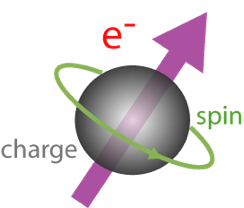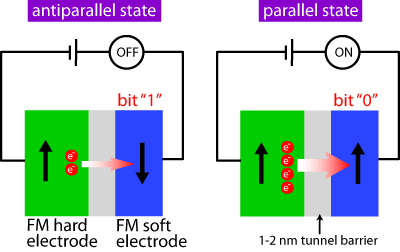

 |
SPAM3 is supported by  |
Starting date: 1 February 2009 |
| ABOUT |
| NEWS |
| SCIENTIFIC BACKGROUND |
| PROJECT OBJECTIVES |
| RESERVED AREA |
| Dr. Roberto Mantovan |
| Tel:+39-039-6036540 |
| email: |
| Laboratorio MDM |
| CNR-IMM, Unita' di Agrate Brianza |
| Via Olivetti, 2 - 20864 |
| Agrate Brianza(MB) - Italy |
SPINTRONICS
The
spin-dependent
electronics (spintronics) is characterized by the use of both
the
electrical charge and the spin of electrons. The operation of
spintronic devices is intimately related to magnetic
phenomena and
to the manipulation of spin-polarized currents. There are
several concepts exploiting the electron spin for the
development of novel devices, and spintronics is indeed an
interesting field for preparing the next generation of micro-
and
nano-electronics [1].

SPINTRONICS FOR NON-VOLATILE MEMORIES
One
of the most competitive solution for
replacing and/or integrating the currently used non-volatile memories
is the magnetoresistive random access memory (MRAM), where the
elemental memory cell is the magnetic
tunnel junction (MTJ). Essentially,
a MTJ stack consists of two ferromagnetic (FM) layers acting as
electrodes separated by a thin oxide film, the tunnel barrier. The
spin-polarized current-flow in a MTJ is generally manipulated by an
external current-induced magnetic field, which controls the relative
magnetization orientation of the FM electrodes. The storage element
in MTJs is constituted by the soft (also called free)
electrode
magnetization, being intrinsically non-volatile. The read-out of the
data is possible due to the
possibility of obtaining different perpendicular-to-plane resistances
of the MTJ stack, being maximum RAP (minimum RP)
in the antiparallel
(parallel) FM electrodes magnetization configurations. The efficiency
of the read-out process is defined by the magnitude of the tunnel
magnetoresistance (TMR), defined as TMR= (RAP-RP)/RP.
MRAM are fast,
non-volatile and easy accessible with infinite
endurance, a likely candidate for becoming the
"universal memory".
The
first observation of a TMR was done by Julliere in 1975 in a Fe/Ge/Fe
stack prototype device at 4.2 K [2]. A major breakthrough was achieved
in 1995 by the Moodera's group that first observed a finite
TMR
effect at room temperature for a Fe/Al2O3/Co
MTJ [3]. Since
then, a
large number of pubblications reported finite TMR values in a large
varity of different multilayer stacks. In 2004 the grops of S.
Yuasa and S. S. P. Parkin have reported record TMRs for epitaxial MTJs
employing MgO tunnel barriers [4,5], where the MTJs were fabricated by
molecular beam epitaxy and magnetron sputtering respectively.

MTJ BASED ON THE SPIN TRANSFER TORQUE MECHANISM
Slonczewski predicted
in 1996 the possibility of inducing the magnetization switching in
magnetic thin films by
using
spin-polarized currents [6]. The possibility to electrically
manipulate the
magnetization direction of thin films is very much attractive for
application
in spintronics. Consider a typical MTJ stack. The current passing
through the hard FM electrode (polarizer)
will be fully spin-polarized in the direction determined by the
polarizer magnetization direction. In favorable conditions, the
tunneling (spin
polarized) current could "kick" the soft FM electrode magnetization
inducing its reversal thank to the spin transfer torque (STT) induced
by the
spin
polarized electrons. The
STT
effect can be explained by considering an additional term in the
Landau-Lifshitz-Gilbert
equation that takes into account the torque inferred to the
magnetization of a thin
film by the spin polarized injected carriers [7]. Such a STT process
could align
the magnetization directions of the FM electrodes. If the current is
reversed
(passing first through the soft FM electrode), the carriers having the
spins pointing in the opposite direction with respect to the hard FM
electrode magnetization, will be reflected back into the soft electrode
then possibly
aligning
the soft magnetization direction antiparallel to the hard polarizer
magnetization.
The
STT-based reversal of the
magnetization direction in thin films is strongly dependent on the
material properties, which critically determine whether the
induced torque can overcome the damping effect that is forcing
the
magnetization in the easy axis direction.

The STT mechanism offers a very attractive way for manipulating the magnetization state of magnetic thin films. The success in writing a MTJ cell with the use of spin-polarized currents rather then externally induced magnetic fields (through wires), is a fundamental step toward the realization of a full electrically-controlled non-volatile magnetic memory [8]. The dimensionality of the FM electrodes and particularly the electrodes lateral size, are crucially determining the chances of observing a STT-driven magnetization reversal. Therefore advanced lithographic methods are demanding for the fabrication of electrically writable MTJs.
[1] S. A. Wolf, D. D. Awschalom, R. A. Buhrman, J. M. Daughton, S. von Molnar, M. L. Roukes, A. Y. Chtchelkanova, and D. M. Treger, Science 294, 1488 (2001).
[2] M. Julliere, Phys. Lett. 54A, 225 (1975).
[3] J. S. Moodera, L. R. Kinder, T. M. Wong, and R. Meservey, Phs. Rev. Lett. 74, 3273 (1995).
[4] S. Youasa, T. Nagahama, A. Fukushima, Y. Suzuki, and K. Ando, Nat. Mat. 3, 868 (2004).
[5] S. S. P. Parkin,C. Kaiser, A. Panchula, P. M. Rice, B. Hughes, M. Samat, and S. Yang, Nature Mat. 3, 862 (2004).
[6] J. C. Slonczewski, J. Magn. Magn. Mat. 159, L1 (1996).
[7] D. C. Ralph and M. D. Stiles, J. Magn. Magn. Mat. 320, 1190 (2008).
[8] C. Chappert, A. Fert, and F. N. Van Dau, Nature 6, 813 (2007).